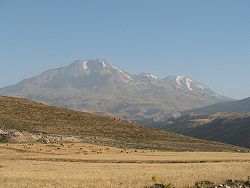Sabalan
| Sabalan | |
|---|---|
 Sabalan | |
| Vrchol | 4811 m n. m. |
| Prominence | 3283 m |
| Seznamy | Ultraprominentní hory |
| Poloha | |
| Světadíl | Asie |
| Stát | |
| Souřadnice | 38°16′1″ s. š., 47°50′13″ v. d. |
| Typ | stratovulkán |
| Erupce | nečinný |
| Některá data mohou pocházet z datové položky. | |
Sabalan (persky: سبلان Sabalân, ázerbájdžánsky: Sāvālān) je vyhaslý stratovulkán, nacházející se v severním Íránu v provincii Ardabil, nedaleko pobřeží Kaspického moře, asi 160 km východně od Tabrízu. S výškou 4811 m je to druhá nejvyšší íránská sopka (po Damávandu) a třetí nejvyšší hora Íránu. Vulkanická stavba je tvořená převážně andezity s velkým rozpětím 5,6 až 1,4 mil. let. Nejnovější výzkumy posouvají hranici poslední činnosti do mladších dob.
Přístup
Vrchol je poměrně lehce dostupný, ročně na něj vystoupí stovky amatérských horolezců.
Odkazy
Externí odkazy
 Obrázky, zvuky či videa k tématu Sabalan na Wikimedia Commons
Obrázky, zvuky či videa k tématu Sabalan na Wikimedia Commons - Popis výstupu na Sabalan
Média použitá na této stránce
Flag of Iran. The tricolor flag was introduced in 1906, but after the Islamic Revolution of 1979 the Arabic words 'Allahu akbar' ('God is great'), written in the Kufic script of the Qur'an and repeated 22 times, were added to the red and green strips where they border the white central strip and in the middle is the emblem of Iran (which is a stylized Persian alphabet of the Arabic word Allah ("God")).
The official ISIRI standard (translation at FotW) gives two slightly different methods of construction for the flag: a compass-and-straightedge construction used for File:Flag of Iran (official).svg, and a "simplified" construction sheet with rational numbers used for this file.
This is a solid red equilateral triangle, which can symbolize or indicate many things, including the the symbol for fire in the books by Franz Bardon.
Autor: Uwe Dedering, Licence: CC BY-SA 3.0
Topographic map of the Iranian plateau in Central Asia, connecting to Anatolia in the west and Hindu Kush and Himalaya in the east.




